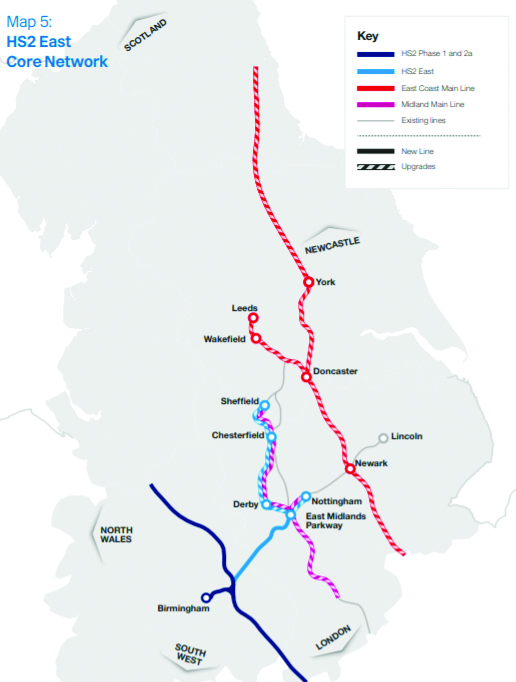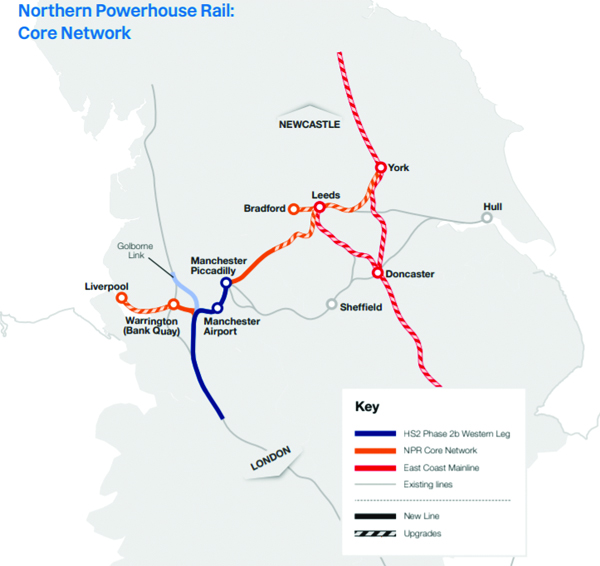The Government has axed the majority of the eastern leg of HS2, which will now stop at East Midlands Parkway instead of Leeds, and abandoned regional hopes of a new high speed line across the north, with the Northern Powerhouse Rail (NPR) concept relegated to a series of upgrades.
The curtailed plans unveiled today amount to a £96bn investment but only around £40bn is thought to be new money, as the rest was already allocated to HS2.
The £40bn of new money is also roughly in line with Network Rail Control Period Spending. The initial plans for Control Period 6 (2019-2024) for instance allocated around £47.9bn to be spent on the railway.
At the heart of the new proposals, the Government pledged major electrification across the main lines, a mass transit system for Leeds and suggested that, further to review, there could still be future upgrades to support cities that have been left behind.
In total, the Government plans to electrify more than 180 miles of the network, meaning that 75% of the country’s main lines will be electrified.
Ministers stressed that in the short-term, the planned reduction in journey times will be relatively unaffected, despite the drastic cutbacks to the original rail plans, though of course the extra capacity and long-term resilience of the wider plans will be lost.
According to initial figures space for up to around 21,000 extra commuters into Leeds will be created under the plans, compared with up to 42,000, which was originally planned. Bradford is facing a similar drop in capacity.
Prime minister Boris Johnson said: 'Levelling up has to be for everyone, not just the biggest cities. That’s why we will transform transport links between our biggest cities and smaller towns, ensuring we improve both long-distance and vital local services and enabling people to move more freely across the country wherever they are.'
Labour's transport spokesman Jim McMahon said: 'It's laughable that the Government expects people in the North to be grateful for some half-baked and repackaged plans, as they attempt to quietly back out of promises made on the vital major infrastructure projects those communities need so badly.
'Failure to deliver on HS2 and Northern Powerhouse Rail – schemes ministers have committed to dozens of times – is not only insulting, it is actively holding back investment and opportunity that could benefit millions.'

HS2 goes West, but doesn't get very far East
Under the Government's Integrated Rail Plan released today, the Government confirmed plans to complete HS2 from Crewe to Manchester, with new stations at Manchester Airport and Manchester Piccadilly
However, the Eastern leg of HS2, (HS2 phase 2b) will not continue to Leeds as originally planned, but run between Birmingham and East Midlands Parkway.
An 'upgraded and electrified Midland Main Line' will take services onwards to central Nottingham, Derby and Sheffield.
HS2 East, as it is now called, will be developed 'based largely on the existing safeguarded route, but designed to allow trains to reach the existing stations in Nottingham and Derby, and to be capable of future extension', the report states.
'This should allow Derby and Nottingham journeys to London in less than 60 minutes, and Nottingham to Birmingham journeys in around 26 minutes, significantly faster than under previous proposals, which would have required passengers to change at Toton.'
To further support eastern connectivity, the Government pledged to complete the electrification of the Midland Main Line, which is already being electrified to Market Harborough, to Leicester, Nottingham and Sheffield via Derby.
Ministers also pledged further investment on the East Coast Main Line (ECML) from London to Leeds and the North East: 'We will ensure digital signalling is delivered and also upgrade the power supply to allow longer and more frequent trains, increase maximum speeds up to 140mph in some places, improve the capacity of stations, and remove bottlenecks such as flat junctions and crossings.'
As a sweetener for Leeds, the Government pledged £200m 'to start work on the West Yorkshire Mass Transit System and to look at options on how to take HS2 trains to Leeds'.
Plans for a tram network for Leeds have been on the books at both the local authority and the Department for Transport for many years, but the concept has a habit of falling at the final hurdle before delivery.
Ministers promised to undertake 'a study to understand the most optimal solution for Leeds station capacity – particularly in light of post COVID-19 demand and our commitment to the Mass Transit System which could take a number of local services out of the heavy rail station at Leeds'.
The Government also said it will 'accelerate transport improvements at Toton, such as a station for local/regional services, with delivery subject to significant private sector investment – on a 50:50 matchfunded basis with the taxpayer – coming forward at the site and developer contributions'.

Northern Powerhouse Rail: upgrades not optimumsMinisters have ignored the statutory recommendations of Transport for the North - the sub-national transport body for the region - and rejected plans for a new NPR line.
TfN had called for an entirely new-build high speed line between Leeds and Manchester, with a new central station underground at Warrington and an underground station in the vicinity of the existing Bradford Interchange station.
Instead the Government has opted for upgrades to the existing lines into Leeds (via Huddersfield) and Liverpool (via Warrington Bank Quay) as well as 40 miles of newbuild high speed line between Warrington, Manchester and Yorkshire (to the east of Standedge tunnels) - though this was largely already planned under HS2 plans.
There will also be:
- An additional £625 million in new funding was confirmed to progress the Transpennine Route Upgrade.
- Full electrification and upgrade of the Transpennine Main Line between Manchester, Leeds and York as the first phase of the reduced NPR,
- installing full digital signalling, with longer sections of three- and four-tracking to allow fast trains to overtake stopping services, and increase through passenger services by 20%.
- electrification of Leeds–York with some sections of four-tracking;
- upgrades and electrification of the Leeds–Bradford section of the Calder Valley Line; and
- reinstatement of Warrington Bank Quay low level station; upgrading and electrifying existing lines between Warrington and Liverpool; and enhancing Liverpool Lime Street station.
- a £360m fund for contactless ticketing, shifted to focus on the North.
Register now for full access
Register just once to get unrestricted, real-time coverage of the issues and challenges facing UK transport and highways engineers.
Full website content includes the latest news, exclusive commentary from leading industry figures and detailed topical analysis of the highways, transportation, environment and place-shaping sectors.
Use the link below to register your details for full, free access.
Already a registered? Login